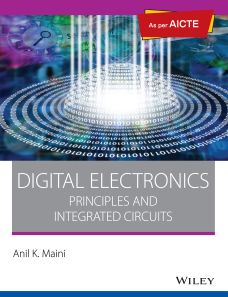Digital Electronics, As per AICTE: Principles and Integrated Circuits
ISBN: 9788126508631
608 pages
For more information write to us at: acadmktg@wiley.com

Description
The fundamentals and implementation of digital electronics are essential to understanding the design and working of consumer/industrial electronics, communications, embedded systems, computers, security and military equipment. Devices used in applications such as these are constantly decreasing in size and employing more complex technology. It is therefore essential for engineers and students to understand the fundamentals, implementation and application principles of digital electronics, devices and integrated circuits. This is so that they can use the most appropriate and effective technique to suit their technical need.
Chapter-1: Number Systems And Codes
1.1. Analogue Versus Digital
1.2. Introduction To Number Systems
1.3. Decimal Number System
1.4. Binary Number System
1.5. Octal Number System
1.6. Hexadecimal Number System
1.7. Number Systems – Some Common Terms
1.8. Number Representation In Binary
1.9. Finding The Decimal Equivalent
1.10. Decimal-To-Binary Conversion
1.11. Decimal-To-Octal Conversion
1.12. Decimal-To-Hexadecimal Conversion
1.13. Binary-Octal And Octal-Binary Conversions
1.14. Hex-Binary And Binary-Hex Conversion
1.15. Hex-Octal And Octal-Hex Conversions
1.16. The Four Axioms
1.17. Floating-Point Numbers
1.18. Binary Coded Decimal
1.19. Excess-3 Code
1.20. Gray Code
1.21. Alphanumeric Codes
1.22. Seven-Segment Display Code
1.23. Error Detection And Correction Codes
Chapter-2: Digital Arithmetic
2.1. Basic Rules Of Binary Addition And Subtraction
2.2. Addition Of Larger Bit Binary Numbers
2.3. Subtraction Of Larger Bit Binary Numbers
2.4. Bcd Addition And Subtraction In Excess-3 Code
2.5. Binary Multiplication
2.6. Binary Division
2.7. Floating-Point Arithmetic
Chapter-3: Logic Gates And Related Devices
3.1. Positive And Negative Logic
3.2. Truth Table
3.3. Logic Gates
3.4. Universal Gates
3.5. Gates With Open Collector/ Drain Outputs
3.6. Tristate Logic Gates
3.7. And-Or-Invert Gates
3.8. Schmitt Gates
3.9. Special Output Gates
3.10. Fan-Out Of Logic Gates
3.11. Buffers And Transceivers
3.12 Ieee/Ansi Standard Symbols
3.13 Application-Relevant Information
Chapter-4: Logic Families
4.1. Logic Families – Significance And Types
4.2. Characteristic Parameters
4.3. Transistor Transistor Logic (Ttl)
4.4. Emitter Coupled Logic
4.5. Cmos Logic Family
4.6. Bicmos Logic
4.7. Nmos And Pmos Logic
4.8. Integrated Injection Logic (I2l) Family
4.9. Comparison Of Different Logic Families
4.10. Guidelines To Using Ttl Devices
4.11. Guidelines To Handling And Using Cmos Devices
4.12. Interfacing With Different Logic Families
4.13. Classification Of Digital Ics
4.14. Application-Relevant Information
Chapter-5: Boolean Algebra And Simplification Techniques
5.1. Introduction To Boolean Algebra
5.2. Postulates Of Boolean Algebra
5.3. Theorems Of Boolean Algebra
5.4. Simplification Techniques
5.5. Quine-Mccluskey Tabular Method
5.6. Karnaugh Map Method
Chapter-6: Arithmetic Circuits
6.1. Combinational Circuits
6.2. Implementing Combinational Logic
6.3 Arithmetic Circuits - Basic Building Blocks
6.4. Adder - Subtractor
6.5. Bcd Adder
6.6. Carry Propagation–Look-Ahead Carry Generator
6.7. Arithmetic Logic Unit (Alu)
6.8. Multipliers
6.9. Magnitude Comparator
6.10. Application-Relevant Information
Chapter-7: Combinational Logic Circuits
7.1. Multiplexer
7.2. Encoders
7.3. Demultiplexers And Decoders
7.4. Parity Generation And Checking
7.5. Application-Relevant Information
Chapter-8: Flip-Flops And Related Devices
8.1. Multivibrator
8.2. Integrated Circuit (Ic) Multivibrators
8.3. R-S Flip-Flop
8.4. Level-Triggered And Edge-Triggered Flip-Flops
8.5. J-K Flip-Flop
8.6. Toggle Flip-Flop (T Flip-Flop)
8.7. D Flip-Flop
8.8. Synchronous And Asynchronous Inputs
8.9. Flip-Flop Timing Parameters
8.10. Flip-Flop Applications
8.11. Application-Relevant Data
Chapter-9: Counters And Registers
9.1. Ripple (Asynchronous) Counter
9.2. Synchronous Counter
9.3. Modulus Of A Counter
9.4. Binary Ripple Counter - Operational Basics
9.5. Synchronous (Or Parallel) Counters
9.6. Up/Down Counters
9.7. Decade And Bcd Counters
9.8. Presettable Counters
9.9. Decoding A Counter
9.10. Cascading Counters
9.11. Designing Counters With Arbitrary Sequences
9.12. Shift Register
9.13. Shift Register Counters
9.14. Ieee/Ansi Symbology For Counters And Registers
9.15. Application-Relevant Information
Chapter-10: Data Conversion Circuits – D/A And A/D Converters
10.1. Digital-To-Analogue Converters
10.2. D/A Convertor Specifications
10.3. Types Of D/A Converters
10.4. Modes Of Operation
10.5. Bcd-Input D/A Converter
10.6. Integrated Circuit D/A Converters
10.7. D/A Converter Applications
10.8. A/D Converters
10.9. A/D Converter Specifications
10.10. A/D Converter Terminology
10.11. Types Of A/D Converters
10.12. Integrated Circuit A/D Converters
10.13. A/D Converter Applications
Chapter-11: Programmable Logic Devices
11.1. Fixed Logic Versus Programmable Logic
11.2. Programmable Logic Devices: An Overview
11.3. Programmable Roms
11.4. Programmable Logic Array (Pla)
11.5. Programmable Array Logic (Pal)
11.6. Generic Array Logic (Gal)
11.7. Complex Programmable Logic Devices
11.8. Field-Programmable Gate Arrays
11.9. Programmable Interconnect Technologies
11.10. Design And Development Of Programmable Logic Hardware
11.11 Programming Languages
Chapter-12: Microprocessors
12.1. Introduction To Microprocessors
12.2. Evolution Of Microprocessors
12.3. Inside A Microprocessor
12.4. Basic Microprocessor Instructions
12.5. Addressing Modes
12.6. Microprocessor Selection
12.7. Programming Microprocessors
12.8. Risc Versus Cisc Processors
12.9. 8-Bit Microprocesesors
12.10. 16-Bit Microprocessors
12.11. 32-Bit Microprocessors
12.12. Pentium Series Of Microprocessors
12.13. Microprocessors For Embedded Applications
12.14. Peripheral Devices
Chapter-13: Microcontrollers
13.1. Introduction To Microcontroller
13.2. Inside The Microcontroller
13.3. Microcontroller Architecture
13.4. Power Saving Modes
13.5 Interfacing Peripheral Devices With A Microcontroller
Chapter-14: Memory Devices
14.1. Anatomy Of A Computer
14.2. A Computer System
14.3. Computer Memory
14.4. Random Access Memory (Ram)
14.5. Read Only Memory (Rom)
14.6. Expanding Memory Capacity
14.7. Secondary Storage Or Auxillary Storage

